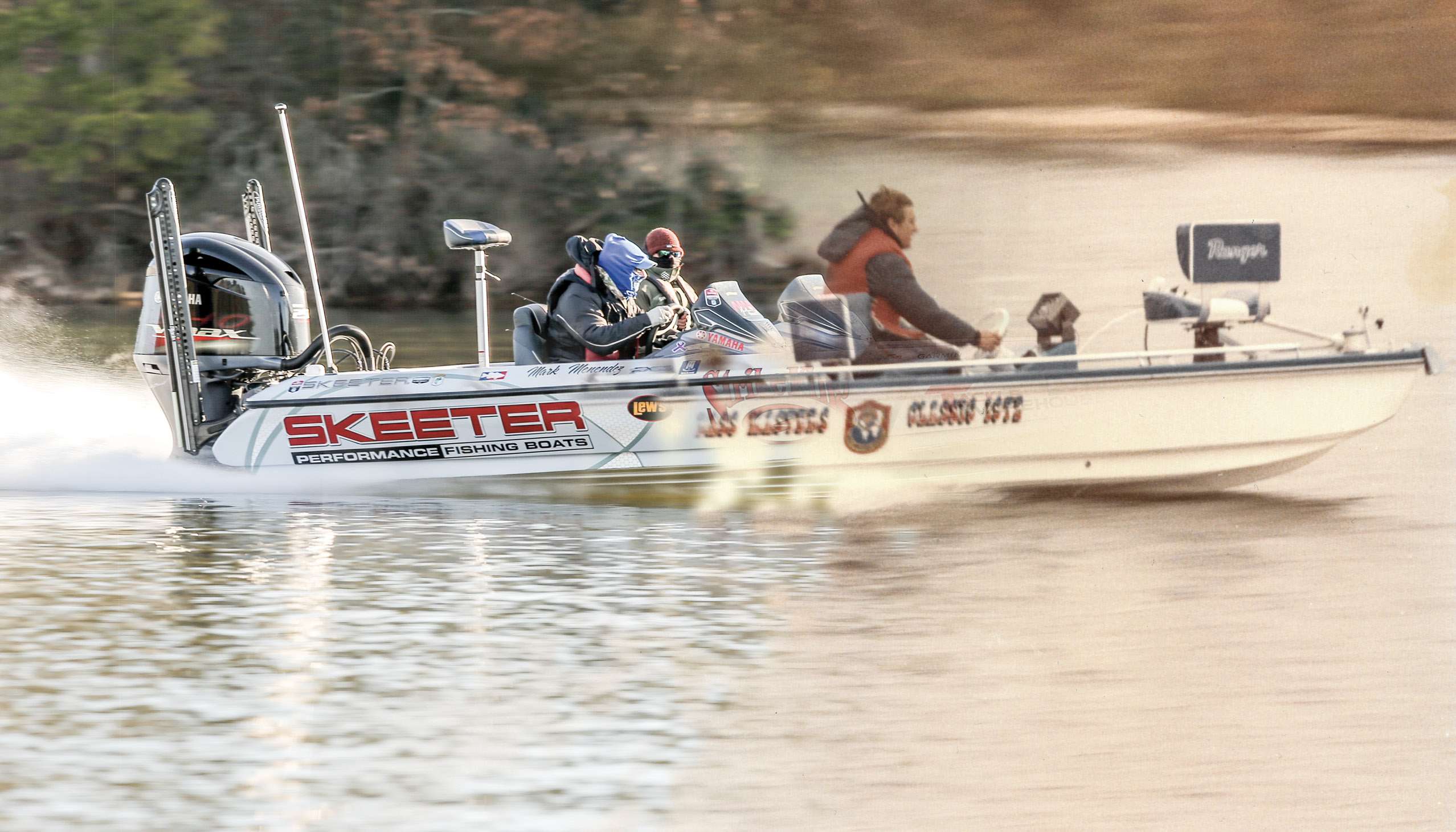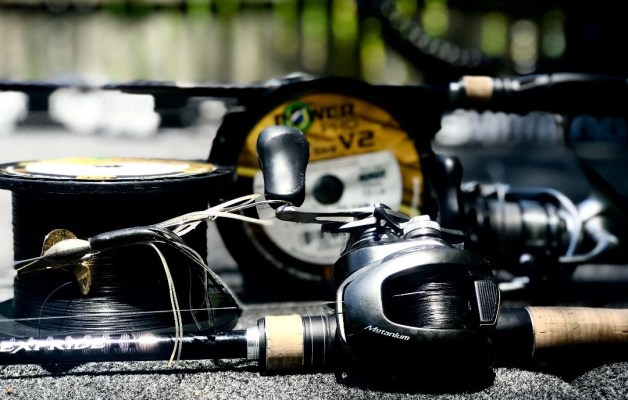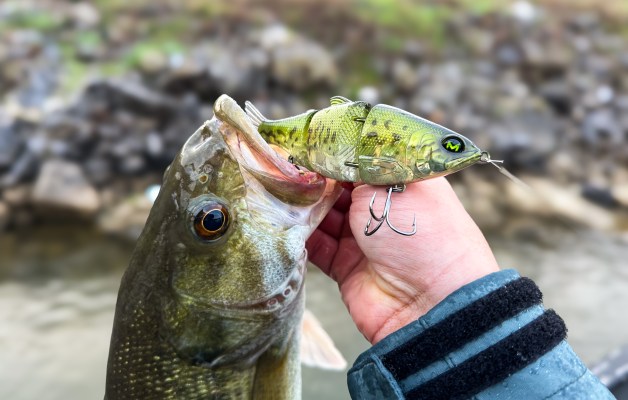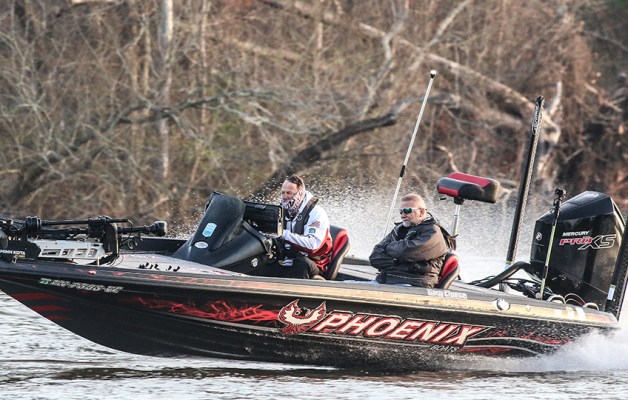
The past 50 years of bass boat innovations have been like going from the invention of the wheel to rocket ships. Before Ray Scott founded the Bass Anglers Sportsman Society (B.A.S.S.) in 1967, the typical “bass boat” was an aluminum flat-bottom boat powered by a small tiller outboard. A hand-controlled electric maneuvering motor was fixed to the transom.
Soon after the founding of B.A.S.S., MotorGuide’s newfangled bow-mounted, foot-controlled electric motor became one of the earliest and most essential bass-boat innovations. In 1969, Forrest Wood’s first six Ranger bass boats had bow space to support an electric motor.
Ranger, Skeeter and a few other companies were making flat-bottomed, blunt-nosed fiberglass boats specifically for bass fishing at this time. These boats had no livewells. A 6-gallon tank on the floor near the transom supplied the fuel, and stick steering from the bow seat was common.

1970s
Bass Cat introduced its maiden bass boat in 1971. It had console steering and was rated for a 135-horsepower outboard. Console steering quickly and universally replaced stick steering, which has inherent safety issues.

Ranger unveiled three TR models in 1972. The largest of these was the 17-foot, 10-inch Ranger 18, which had a 64-inch beam.
In 1972, Mercury introduced its first 150-hp outboard. This “Tower of Power” was extravagantly tall, due to having six vertically stacked cylinders.
Ranger patented an aerated livewell system in 1973, which became standard on its boats. All bass boat manufacturers begin to add livewells and livewell plumbing, as well as permanent gas tanks.
Due to anglers being tossed from their boats and run over by them, B.A.S.S. made kill switches mandatory for tournaments in 1974. Outboard makers responded by making kill switches standard on all their motors.
A trim switch for the throttle handle, another safety feature, came along in late 1974. Prior to this, the trim was controlled by a toggle switch on the dashboard. In honor of its Trim Handle, the company adopted the name T-H Marine.
The first V-bottom fiberglass bass boat, Skeeter’s Wrangler, hit the market in 1975. It astonished anglers with speeds of over 60 mph when pushed by Mercury’s Tower of Power. The Wrangler marked the beginning of the move away from flat bottoms and tri-hulls to the V-hull, which delivers better performance and a much smoother ride on rough water.
That same year, boat-racing champion Earl Bentz accepted a position with Hydra-Sports. His contribution to bass boat performance and advancement ripples through the boating industry to this very day.

MotorGuide pioneered the first 12/24-volt electric motor in 1975, doubling the motor’s power for more efficient boat control.
Mercury debuted the first V6 outboard, the 1750, in 1976. It generated 175 horsepower at the crankshaft and quickly became commonplace on bass-boat transoms.
During the mid-’70s, bass-boat makers took note of racing hulls designed by Paul Allison of Allison Boats and added running pads to their V-hulls. Driving these early pad boats without chine walking was like learning how to ride a unicycle. Porpoising at slow speeds was a common problem that boat makers had to overcome by tweaking their hulls.
To achieve ultimate performance, bass boat manufacturers found ways put the outboard’s prop farther behind the running pad. This helped the engine lift the bow, which dramatically increased top-end speed. One modification was moving the running pad farther forward from the transom. Another was fixing a jackplate to the transom to set the motor farther back and to raise it higher for less drag.
In the spring of 1977, T-H Marine offered the first commercially available foot throttle for boats. It allowed steering with both hands while maintaining instant throttle response.
In the fall of 1979, T-H Marine introduced the HI-JACKER adjustable jackplate, the first commercially available, off-the-shelf jackplate.
1980s
Ranger was the first to introduce an E-Z lube bearing grease system on Ranger Trail trailers in 1981. Two years later, it pioneered a revolutionary molded-fiberglass stringer system to replace wood stringers, which inevitably rot.
Earl Bentz became president and founder of Stratos Boats in 1983 and designed the first bass boat with a step pad hull. He also did away with the fuse system that was standard on bass boats of the day and replaced it with automatic-reset circuit breakers. And, Bentz was the first to upgrade from the standard 10-gauge wire used for trolling motors to heavier, more efficient 6-gauge wire.
Yamaha brought out a line of outboards for leisure use in 1984, including a 220-hp V6. These motors featured the first oil injection system that eliminated manual mixing of oil and gas.
Bass Cat unveiled its Pantera Pro in 1984. It was the first 19-foot bass boat rated for a 200-hp outboard. It accomplished this by increasing the beam to 92 inches, which allowed the hull to support heavier outboards.
In 1985, the model 181 Stratos featured a flipping deck that was barely lower than the gunnels. Prior to this, bow-fishing decks were several inches below the gunnel and interfered with the backward swing of the flip-cast. Flipping decks soon became standard on all serious fiberglass tournament boats.
Ranger introduced its first models with pultruded fiberglass transoms and parts in 1987. The material is stronger than wood and impervious to water. Ranger also became the first to put disc breaks on boat trailers.
Mercury EFI outboards replaced carburetors with direct fuel injection on its 2.4-liter motor platform in 1987, which included a 225-hp model.
The weight of higher horsepower outboards prompted bass boat manufacturers to design boats longer than 20 feet that had wider beams. From that time until the present day, bass boat makers have had to constantly refine their hulls to achieve optimum performance with larger boats and the heavier loads they must carry.
Onboard battery chargers became standard on Bass Cat boats in 1988. Prior to this, they were optional. Onboard chargers soon became standard on all bass boats.

1990s
Bass Pro Shops jumped into the fiberglass boat market with the introduction of its new high-performance tournament offering: Nitro.
In 1991, Ranger was the first to design and engineer an integrated engine setback into the transom, which improved overall boat performance.
Bass Pro Shops purchased Nitro Boats and produced its first Nitro 185 model in 1991.
Bass Cat put forth its Eyra in 1994, which was the first bass boat made with an inset on the bow deck for the trolling motor pedal. All top-end bass boats quickly adopted this essential feature.

Skeeter’s ZX series hit the market in the early ’90s. These boats featured hull sponsons that improved stability while fishing, floated the boat at a more level attitude and reduced waves washing onto the rear deck as the boat comes off plane. “Rod Staze” retractable cords secured rods to the deck while running.
Ranger was the first to feature hydraulic steering as standard equipment on its boats equipped with V6 engines in 1995.
In 1996, Mercury’s OptiMax line of direct fuel injection outboards significantly increased fuel economy, reduced emissions and improved oil lubrication into critical points.
When Earl Bentz founded Triton Boats in 1996, he did extensive research to eliminate marine plywood. He discovered that bonded fiberglass is 30% lighter and has twice the sheer strength of plywood, given the same thickness.

In 1997, Triton introduced its Tr-21 Pro, the first fully composite bass boat that eliminated wood. Other major bass boat brands followed suit.
Around this time, the MotorGuide 500 hit the market and was the first 36-volt, cable-steer trolling motor. It produced a higher thrust and a longer running time than that of 24-volt motors, something that was badly needed for large bass boats.
2000-2009
Minn Kota’s Maxxum, the company’s first 36-volt, cable-steer trolling motor, came out in 2000. It had a thrust rating of 101 pounds and featured a 360-degree breakaway mount. It is still in the Minn Kota line.
In 2001, a newly developed Torque Transfer Transom and Stringer System in Skeeter ZX bass boats transferred torque from the engine to the stringers in the hull to eliminate stress and provide more lift.
Mercury launched its first 4-stroke outboard, the Verado, in 2004. It was available in V4 and V6 models beginning at 175 horsepower.
Digital touch keypads on Skeeter’s 2006 i-Class series were another first for bass boats.
Power-Pole debuted its hydraulic 8-foot mechanical anchor specifically for bass fishing in 2008. This device proved so effective that any serious tournament angler who didn’t have dual Power-Poles on his transom was severely handicapped.
Phoenix Bass Boats entered the market in the spring of 2008 with its first 18- and 21-foot models. President Gary Clouse, an Elite Series pro, had an extensive history working with Stratos, Champion and Triton boat companies. Innovative Phoenix features included the first fully-enclosed driver’s console, a passenger console that could be easily installed or removed and insets for large graphs in the bow and the driver’s console.
2010-2020
Yamaha broke ground in 2010 with the 4-stroke 4.2-liter VMAX SHO. It was light, delivered strong mid-range acceleration and was available in models to 250 horsepower.
Minn Kota launched its first generation of 6- and 8-foot electro-mechanical Talon shallow-water anchors in 2011.
The Minn Kota Ultrex electric motor changed the game in 2016. It featured electric steering that had a cable-like foot-pedal response combined with electronic GPS anchoring. Other companies came out with motors that had these remarkable features in 2019, including Garmin’s Force and MotorGuide’s Tour Pro.
In May 2018, Mercury launched a new V8, 4.6-liter outboard engine platform. The engines were lightweight, powerful, fuel efficient and available in 175- to 450-hp models.

Earl Bentz founded Caymas Boats and unveiled his first bass-boat models, the Caymas CX-20 and CX-21, in September 2018. He invested his more than 50 years of performance boating knowledge to give Caymas boats a soft, dry ride and the ability to carry the weight of a powerful outboard and all the modern amenities available these days, such as mechanical anchors. An exclusive Hi-Speed Livewell Pick-Up system kept livewells full to the brim while running on plane to prevent harming bass while running on rough water.

The VX20 and VX21 fiberglass bass boats ushered in by Vexus Boats in 2019 were molded with revolutionary vacuum infusion. Vacuum infusion produced a more consistent hull weight and thickness than could be achieved with chopper guns and hand-laid fiberglass. The result was a lighter and stronger hull. The final finish was a hard, deep-luster automotive paint, which is more durable than gelcoat and less prone to sun fading. Among the many other features were Air Wave suspension seats, insets on the driver’s console and bow for the largest electronics and a livewell that could be filled to the brim to protect bass during rough-water boat rides.
Originally appeared in Bassmaster Magazine 2020.





